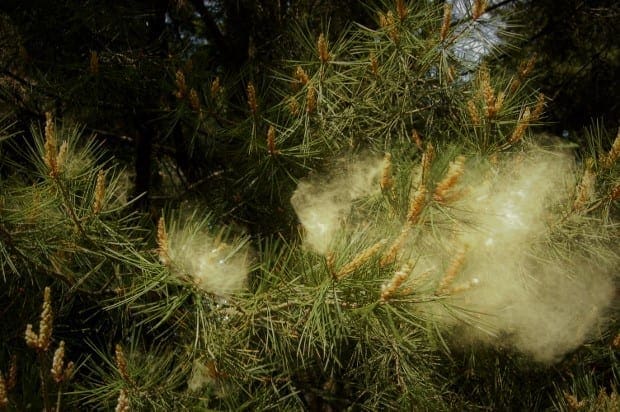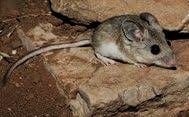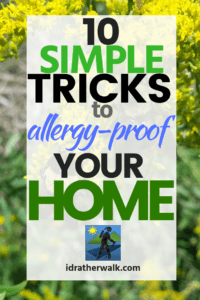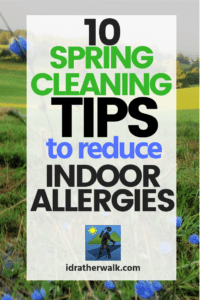Most recently updated July 7th, 2023
Spring!
It’s the time of year when trees in the South release massive clouds of yellow pollen into the wind, to be distributed to allergy-prone noses and lungs everywhere.
Around here, it’s known as “The Pollening”.

Even if you don’t live in the South, it isn’t unusual to find your allergies heating up along with the air temperature.
The horrors of pollen season are so well-known that years ago, when my boyfriend told me he’d be unavailable for a few weeks due to severe allergies, I had nothing but sympathy for him.
Much later, I realized that my boyfriend’s allergies struck at exactly the same time as the “March Madness” basketball playoffs. Hmmm…

I’m not as gullible now, but I still have nothing but sympathy for people with allergies 🙂
If you have allergic asthma symptoms throughout the year (like I do), or even seasonal allergies and asthma, you can’t do much about what’s floating around in the air outside.
What you can do is take steps to control allergens inside your home, so you can breathe and rest easier year round.
According to the The American Lung Association, the air quality inside your home could be 2-5 times worse than the air outdoors.
That’s not good, since research says some of us spend up to 90% of our time indoors.
Triggers like pollen, chemicals, pet dander, dust, and mold all contaminate the air indoors.

If your main allergen is tree pollen or leaf mold, spending more time outside instead would be like going from the frying pan into the fire.

It would be better to avoid your allergens altogether.
So, what can you do?
THERE IS NO CURE FOR ALLERGIES
Research from the Asthma and Allergy foundation of America shows that allergies effect 30 percent of adults and 40 percent of children.
Some of my posts contain affiliate links. If you make a purchase through an affiliate link, I will receive a small payment at no additional cost to you. As an Amazon Associate, and other marketing affiliations, I earn from qualifying purchases. I do not get paid for recommendations, all opinions on this site are my own. See full Disclosure page here.

Unfortunately, no cure exists – all asthmatics and allergy sufferers can do is manage their symptoms.
You can do this with diet, exercise, and trying to control your environment.
Most people also take some kind of over the counter or prescription medication.
Asthma inhalers are the most common and effective way to deliver asthma medicine to your lungs.
Unfortunately, while the medicine can help, it can really slow you down.
I moved 2000 miles to get away from my main allergen – but that was an extreme move to avoid an extreme reaction.
You probably won’t need to go that far 🙂
That said, the best results do usually require a lifestyle change – and that journey begins at home.

I’ve listed a few tips below for making your indoor air more asthma and allergy-friendly.
(I also have mentioned some products that have worked for me to help fight my asthma and allergies; just click on a photo or text link to find out more.)
How To Reduce Allergens in Your Home
To reduce allergens in a newly constructed home, a good carpet cleaning, dusting and a couple days getting the stale air out may be all you need to do.
In an older home, you may need to do some remodeling, repairs and deep cleaning.
In either case, you may also need to retrain yourself and your family to keep your home and indoor air cleaner.
The process may be relatively easy.
The key – developing habits that attack allergens, but don’t spread them further throughout your house – maybe a bit harder.

1. Leave Shoes at the Door

Your shoes have stepped in everything – and are covered with a fine layer of chemicals, dirt, bacteria, and mold! (My shoes are usually hiking boots, and are covered with mud and bits of the forest.)
These contaminates will come indoors on your shoes and settle onto your flooring, carpeting, and rugs.
Then you stir up these particles as you walk around, and your family breathes them in.
Removing your shoes (and wiping your pet’s feet) when you enter the house will significantly reduce the number of lung irritants brought inside.
I keep a small rug in the foyer for people to set their shoes on after they take them off.
It’s also a good idea to keep a welcome mat outside all doors for everyone to wipe their shoes before they come in.
You might also consider leaving a basket of loaner socks or booties in the foyer for guests who are reluctant to remove their shoes 🙂
2. Don’t Decorate With Dirt Traps
The worst dirt trap in your house is wall-to-wall carpeting. The material in carpets acts as a sponge for grime, dander and other particles from traffic.
Vacuuming only sucks up part of this stuff – you have to live with the rest.
If you can, swap out carpets for wood or tile.
Wood or tile floors are easier to clean and hold onto less dirt than carpets – especially if you’ve got pets.
If you can’t do without carpet under your feet, opt for throw rugs.
Unlike installed carpet, throw rugs are machine washable, or you can take them outdoors and shake them.

Embrace Minimalist Decor
Carpet is just one type of home decor that holds on to dirt and allergens.
But, because it’s on the floor, carpet catches all of the allergens that walk in the door plus allergens (like dust and pet dander) that are created inside the home.
Generally, frilly furnishings or items with lots of surfaces are going to be the worst dust collectors – and take the most effort to clean.
Avoid upholstered furniture as much as you can. If you must keep your comfy sofa, use washable covers so you can clean the pet and human dander periodically.
Try to choose easy-to-clean chairs, tables, and dressers made of leather, wood, metal or plastic.
Get rid of non-functional objects such as knickknacks, tabletop ornaments, and displayed books and magazines.
Store children’s toys, games and stuffed animals in plastic bins with lids.
Keep only the items that bring you joy, and don’t collect dust 😉
As long as you’re at it, you might as well get rid of all of your extra stuff. Donate items to a local charity, or a friend or family member who could use them.
Afterward, you’ll be happy both with the clutter-free, dust-free space and knowing you’ve helped someone else.

3. Keep Bad Air Out and Good Air In
Opening a window isn’t always the best choice.
If you have severe allergies, you’re just inviting the vampire in!
Fall and Spring breezes blow pollen, mold, and dust right into your home.
Be sure to check the air quality and pollen levels outside before opting for fresh air.
Cooking can also put triggers in the air: smoke, grease and even spices could make breathing difficult if you have allergies.

Turn on your outdoor venting fan to help smoky air to leave the house when you cook.
And of course, don’t smoke or allow smoking anywhere inside your house.
4. Clean Windows Means More Than Clear Glass
Windows, along with their curtains and blinds, collect dust.
Use washable curtains made of plain cotton or synthetic fabric, and wash them regularly.
Make a habit of wiping the blinds with a soft cloth. (Reduce your workload by substituting plastic blinds for wooden ones.)
Better yet, decorate with a window topper or blinds only. Less is more.
Don’t forget to clean mold and condensation from window frames and sills. Use double-paned windows if you live in a cold climate.
5. Make an Allergy-Proof Bed
Our bedding is one of the dirtiest places in the house.
Filled with dead skin cells, it’s the perfect breeding ground for dust mites.
Make sure your bedding, includes machine-washable comforters or duvets, so you can launder frequently.
to help keep your bedroom allergen-free:
- Replace wool or feather bedding with synthetic materials.
- Encase your mattresses, box springs, and pillows in allergy-proof or airtight zippered plastic covers.
- Remove, wash or cover comforters.
- Wash all bedding weekly in water that is at least 130°F, and dry everything in a dryer on the hottest setting.
6. Breathe Easier with HEPA Air Filters and Purifiers
Anyone who suffers with allergies knows that they tend to get worse at night. This may be due to natural Circadian rhythms, your sleeping position, or even the allergens in your bedding.
Whatever the cause, if you can’t breathe very well or have a constant cough, it’s hard to get to sleep.
If you have central heating or air, you can use filters in your vents that will help to clean the air in your entire house.
Choose HEPA (High efficiency particulate air) filters that you can place in your vents. There are several different ranges of filtration that you can choose. I use the HEPA vent filter from Filtrete, for my HVAC vents.
Whole house air purifiers and vent filters are not as effective as having an air purifier just for single rooms. If your budget allows, consider an additional room purifier for your bedroom.
I have an air purifier in my bedroom and run it each at night with the door shut. The brand I use is Inofia but there are many other good purifiers available.
Place this device near your headrest. Try adjusting to it direct clean air towards your head when you sleep.
For more info, visit the Consumer Reports: Air Purifier Buying Guide.
Don’t forget your other filters!
There are many kinds of filters and screens around your home: dryer lint screens, vacuum cleaners, range hood screens, water filters, and bathroom exhaust fan grilles, for starters.
Be sure to keep them all clean or replace them as needed.
7. Chill Out to Reduce Dust Mites

Dust mites are insects that feed off human dander, and live in your bedding and other upholstered surfaces.
You never see them, because they’re too small – which is a good thing because they’re really creepy.
Hot, humid houses are breeding grounds for dust mites and mold, too. Make your home less hospitable for these allergens by lowering the temperature to somewhere between 68 F (20 C) and 72 F (22 C).
Also, encase pillows, bedding and your mattress with dust mite-proof coverings.
If you know you’re allergic to goose down (like I am) you should swap feather bedding for non-allergenic synthetic materials.
Read 8 Ways to Get Rid of Dust Mites for more suggestions.
8. Insects and Vermin
So here’s another thing we don’t like to think about before bedtime:
Cockroaches hide in walls. They come out at night.
It doesn’t matter what you call them- Plantation Beetles, Palmetto Bugs, or even La Cucaracha – you probably have them, especially if you live in a warmer climate.

What they leave behind, per WebMD, causes nasal allergies. Signs are congestion, chronic coughing and chest tightness.
You might also have an infestation of field mice or other small furry vermin.
It doesn’t mean you are filthy or a bad housekeeper, these pests are just pervasive and hard to get rid of.
HOW TO KEEP THE VERMIN OUT
To remove insect and mouse-related allergens, thoroughly vacuum carpeting and wash hard surfaces.
To prevent re-infestation:

- Seal cracks or other possible entryways.
- Put food away right after a meal.
- Mop up spills on the floor.
- Check pipes for leaks.
- Get a cat.
These steps encourage mice and cockroaches to find another home.
You can control cockroaches and mice with inexpensive traps from the hardware store.
If that doesn’t work, hire a professional exterminator.
The money you spend pays off with better health.
Trash Talk
Do you take out the garbage accumulating in various bins before the kids or dog tip them over? Is there a lid over the one in the kitchen?
Your answer should be ‘yes’. If not, make a few adjustments.
Insects other than roaches (gnats and flies) enjoy rotten food, too. Therefore, it’s a good idea to invest in trashcans with lids and take out full bags before trash day.
9. Wipe Out Mold
In a home, mold is most often found in the kitchen or bathroom, or the laundry room – anywhere there is water.
To prevent a mold infestation, close the doors and windows during warm weather and use air conditioning and dehumidifiers to keep the moisture in the air lower.
When showering or using hot water in the bathroom, use bathroom fans to vent out the steamy air that could cause mold and mildew growth.

If you already have a mold infestation, remove and discard non-washable contaminated materials, such as carpeting.
Clean washable materials and surfaces and wear a protective mask when cleaning away mold.
In The Maids Blog, they recommend white vinegar as a non-toxic way to kill 82% of mold.
For the remaining, while wearing a mask and gloves, use a 5% bleach solution.
If you don’t know where the moisture came from, check the roof and ceilings for water leaks.
Follow-up by checking for plumbing leaks and emptying the drip pans in your HVAC and your refrigerator.
How to Clean Your Shower Curtain

According to research from the University of Colorado at Boulder, the soap scum on your shower curtain may be more than merely unattractive.
In fact, they say vinyl shower curtains are a haven for disease-causing microbes like Sphingomonas and Methylobacterium, which can be dangerous for immuno-compromised individuals.
To rid your shower curtain of scum and microbes, try running it through your washing machine on a gentle setting.
If that doesn’t work, it may be time for a new shower curtain 🙂

10. Pets Are Allergen Carriers
Most doctors suggest that people allergic to animal dander not keep furry pets. I can hear the collective “Nooooooo!” from here. 🙂

If you can’t bear to be parted from your furry friends, or just can’t find a new home for your dog, cat or other furry pet – even at the expense of your own health – at least keep them out of the bedroom.
Ban them from any bedrooms and be sure to keep the doors closed.
Unfortunately, in addition to allergens, your beloved furry friends might also be passing around germs that could potentially make you sick.
In 2011, the National Sanitation Foundation (NSF) ranked pet bowls as number four and pet toys as number seven on the list of the most germ-filled places in your home.
Pet products can harbor bacteria like E. coli, Salmonella, and more.

To prevent animal dander from accumulating, try bathing pets at least once a week – if they’ll let you.
To clean your pet’s food and water bowls, wash them with warm soap and water each day, and disinfect them weekly in the dishwasher.
Also, since your pet licks, chews, and drags toys around the house, it’s a good idea the toys in the wash once in a while and use a non-toxic disinfectant to wipe down any toys that aren’t washable.

YOUR WEEKLY CLEAN ROUTINE
It’s crucial to have a weekly routine to get rid of all dust and pollen that has been brought into the house throughout the week.
If you stick with it, it will truly help minimize the allergic suffering.
Your weekly CLEANing tasks:
- Vacuum carpet and upholstered furniture weekly with a vacuum cleaner that has a small-particle or high-efficiency particulate air (HEPA) filter.
- Damp-mop wood or linoleum flooring.
- Use a damp cloth to clean other surfaces, including the tops of doors, windowsills and window frames.
- Wipe counters, dust wood surfaces, and ceiling fixtures.
- Don’t forget your baseboards – these cleaning hacks might save you some time.
- Don’t forget to clean your walls. This article from the Organised Housewife will help.
There are other weekly cleaning tasks everyone must do, but the ones listed above are specifically designed to reduce indoor allergens.
For a quick anti-allergen cleaning plan before the Holidays, take a look at my Top-Down Wipe-Down task list.
Protect Yourself When Cleaning
If you have allergies, either wear a dust mask or get someone who doesn’t have allergies to help with these tasks.
Also don’t just dust with dry cloths, instead use a damp cloth to avoids lifting dust into the air – and your nose.
Beware of cleaners, as well. Household cleaners, even “green” cleaners often contain chemicals that will give you an allergic reaction.
Your best bet is to use non-toxic cleaners like baking soda, salt, lemon juice, vinegar, and other basic cleaners (like bleach) in a non-aerosol form.
In addition, here are a few more strategies that the EPA recommends for reducing indoor air pollution.
Prevent Asthma & Allergies from Getting Worse
When it comes to controlling asthma and allergy symptoms, prevention can go a long way.
Keeping your home allergen free is one way to stay healthy.
Another way – when the trees are done committing hate crimes – is to get outside. Just sayin’ 🙂
More things you can do to help prevent asthma and allergy attacks are:
- Get a pneumonia and flu shot each year to avoid illnesses that can be triggers
- Take your asthma and allergy medications as prescribed.
- Cover your nose and mouth when spending time outside in cold air

I hope you’ve found these tips and product links helpful.
If you’re battling asthma and allergies, you might be interested in these other posts:
Asthma’s Effects on Mental Health
What’s the Best Medicine for Your Asthma?
Asthma and COVID-19: Are You at Higher Risk?
Clean Your Indoor Air With Houseplants!
Fight Asthma with Vitamins and Supplements
Eat to Breathe Easier – the Best Food for Asthma
Hiking With Asthma! A 3-Step Plan for Success
Thanks for stopping by – see you next time! LJ
To Get New Idratherwalk Posts
sent directly to your inbox (how convenient!) Click this Button
If you like this post, please share it!




LJ has spent much of her free time as a single Mom – and now as an empty-nester – hiking in the US and around the world. She shares lessons learned from adventures both local and in exotic locations, and tips on how to be active with asthma, plus travel, gear, and hike planning advice for parents hiking with kids and beginners of all ages. Read more on the About page.














